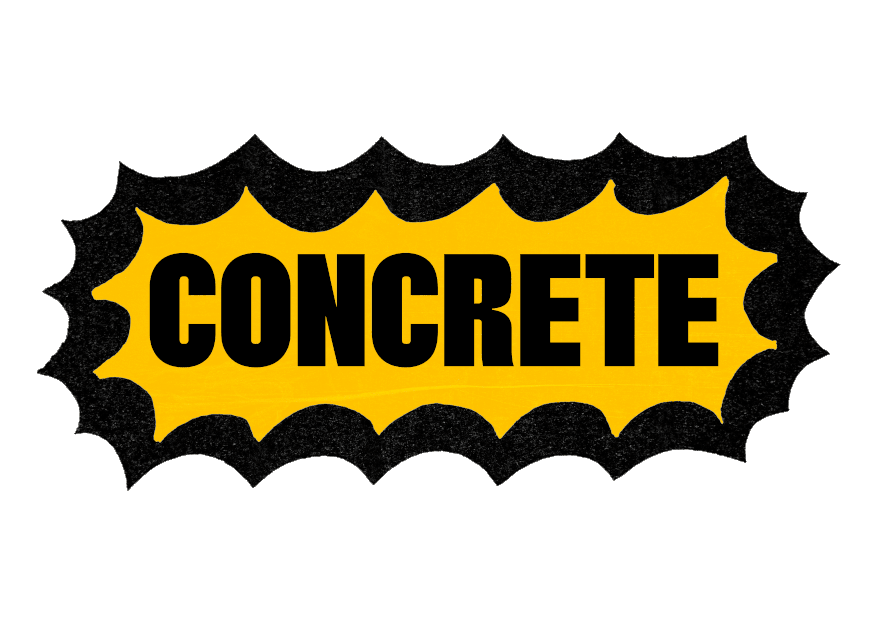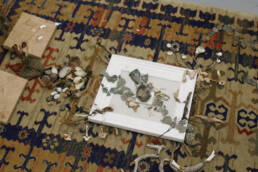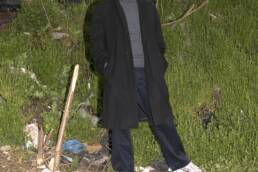CONCRETE meets Cem A., the meme artist behind art meme instagram @freeze_magazine. Cem A. aka @freeze_magazine is the almost anonymous artist behind one of the most successful art meme accounts on Instagram. From our conversation emerged an image of a dedicated practitioner with a vision and a diagnosis of the problems holding the arts back. But what else was I expecting? Cem A. makes memes about the art world – and no one is safe. @freeze_magazine has 105K followers on instagram and his well-aimed jibes utilising the pictorial language of internet culture (namely, memes) are a fitting medium for an online age.

How would you explain @freeze_magazine to a person in the street?
It depends if they know what memes are! It’s a meme page that focuses on art, the art world and recent art history. I am its founder and run the page, but when it comes to explaining what I do it sounds too possessive to say “I’m the artist behind @freeze_magazine”. The account is based on interaction with other people. Followers liking the posts, sharing them again, if it wasn’t for that – the page wouldn’t exist. @Freeze_magazine isn’t my sole work, either. I often collaborate with people on memes and other projects as well. I studied in the UK and have a background in curation. Now I’m thinking of myself more as an artist which is something I’m embracing.
You are almost anonymous. Why and how is that important to your practice?
This question has had different answers at different stages in the page’s growth. At this point, it almost feels like the page has grown too much. I feel a big responsibility; it’s too visible, in some aspects. I’m anonymous because I find it less stressful to not be personally in the public eye. It’s better to not feel watched as a person, to be eyeballed. I like to think I can be more objective if I’m not visible. Visibility causes conflicts.
What experiences have influenced your work?
Again, I think that’s changed a bit as @freeze_magazine almost becomes a platform itself. I’ve been influenced by my experiences in the UK and of its immigration system. By how the art world doesn’t compensate for immigrants and how it felt impossible to get a job in the UK as a non-EU citizen, even pre-Brexit. Studying in the UK comes with the possible promise of getting a job in the art sector in the UK. People from my background don’t exist in the art sector over here, it feels. If you’re not from the Commonwealth, it feels impossible to get a job. It’s an invisible issue.
What is @freeze_magazine focusing on right now?
It’s about many different moments in the art world, and it’s about advocating for change. I can feel myself pushing for that more and thinking about how questioning memes can be. Can memes influence physical change? I’m not sure if that’s possible, but as the account keeps growing the responsibility for me personally, as well as the other people involved in the account, to support meaningful change grows with it. It’s always a compromise. That’s something I’m trying to get across with ‘meme-thinking’. The Overton Window is a concept that I really like, which suggests ideas are on a scale. These ideas go from one extreme, then public opinion, to another, and you get pushed in one direction due to extreme ideas. The ‘window’ is in the middle, the range of ideas which are acceptable in the eyes of the public.

What is instagram doing to art production and dissemination?
I think Instagram is a utopian and dystopian platform. It’s a creative platform with a role in the art world, and it’s an important tool, but on the other hand, everything is filtered through an algorithm which no one actually understands. Instagram is owned by Facebook which gives them more influence, again, to what extent we don’t know. I know some people get censored, too. Instagram constructs how people’s actions produce things. I think this means people subconsciously adapt to fit Instagram.
Institutional critique is a big part of @freeze_magazine. How did you discover institutional critique and what encouraged you to start producing your own?
It was a coincidence. I feel uncomfortable thinking of memes under the umbrella of Institutional Critique. Institutional Critique is a very specific term. A term which – in my mind – blocks memes’ potential. Traditional Institutional Critique is very important, and it has a singular role of constructive criticism, and its logistics are very different to those of memes and meme-making. For memes to work they have to happen organically – not in a corporate or institutional setting. If employees are checking it, fussing and asking, “is this meme ok?” it doesn’t work. I think it’s better to think of memes as a cousin of Institutional Critique, rather than a parent-child relationship. That’s how I see it.
Where do memes fit into art and art discourse? What role do your art memes have within the art world?
I was working on a meme today and the idea was that memes are like different art movements, like Dada, Expressionism, and Pop Art – Fluxus art is a good example, too. I think I would have a bias answering this but in that way, I think memes will go down in history, like an art movement, say, Expressionism has. It’s something to think about. It’s important to remember that these names for influential art movements are artificial descriptions which are applied retrospectively and the conclusions have been drawn after the moment has happened. It also depends on how many people embrace art memes. The production of memes is very invisible. 99% of people don’t know how memes are made. People appreciate memes, but it’s more about the reception of the meme than the production of it. Memes are a moment. I think if you want to be descriptive about it you can say memes draw references from Dada, Pop Art, Symbolism, and you could make an argument that they are all related to memes. I think the critical thing is that it’s something that is still waiting to be defined.
What facets of the art world do you see and dislike? Does irritation drive your memes?
Definitely! I tried everything to quit the art world because of this. I was going to move to another country, or do a PhD, or something else, but nothing worked. Instead I ended up working at documenta fifteen. Now, I am in the art world and I’m embracing it and accepting my fate. It’s almost a cliche, but circumstances put people into different roles and different responsibilities. I think it’s true of the art world. The art world’s other problem is how Western-centric it is. What we describe as “art” is also part of this problem. I think if more people from different backgrounds were given the opportunity to speak their minds, power and privilege would be less important in art. The art world is changing, but it’s happening very slowly.
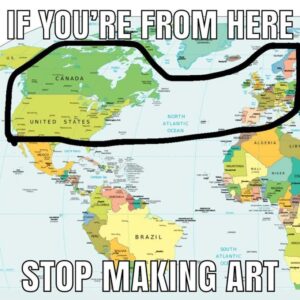
Your memes parody the idiosyncrasies of curator-speak, institutional wrongdoings and “art people”. Why do you think your approach has struck a chord with so many people?
It’s hard to say!! It’s super difficult to make comments to the same effect in person. We are all in the same bubble, so it sounds hypocritical to say these things outright. But on the internet, memes are a good way of sugarcoating the criticism without making people super offended. I’m just responding to what I see. The transparency question is a part of this, too. There’s a paradox in my mind; I don’t want to be visible as a person but I am super happy to talk about my own circumstances.
Like all good memes, the sense of humour is apparent in yours. What does humour give to criticism?
It makes it easier to digest. It becomes more punchy and you can look at it on your phone. Even though I enjoy reading good criticism, it’s easy to get distracted and forget the thrust of the argument mid way through the article. You can’t read criticism on your phone, either. I think attention spans are getting shorter, my own included, and we are more interested in entertainment because it is easier to focus on. Memes are a bite-sized form, again, sugar coated in humour, which can communicate criticism. I like to think memes are a creative space that is more questioning and critical of what we consume. I hope that art memes in the future become more directly critical of individuals, institutions, and artworks, without resorting to personal attacks. I hope to raise the critical ceiling so that conversations about the art world can become more open.
You coined the term “meme-thinking” at your Royal College of Art lecture in 2021. Can you talk a little bit about this term?
It is a made-up word I use as an umbrella term to describe theories I like. Meme-thinking is about using accessibility and popularity as a tool to push for change and to push a constructive agenda in the art world. It’s a word that is very relevant to the lecture and publication projects I have coming up.
What were your aims with your recent installation, The Party?
The aim was to make an exhibition about memes which respected memes as digital-first artworks. I thought about making an exhibition with memes as prints and posters, but I think that goes against the ethos of memes. They have to be made digital, or at least digital first. So the idea of this exhibition was to create an exhibition that would contribute to memes and meme discourse. There are artists I’m inspired by, but for The Party, it was just about building the scene, and I didn’t take in direct references. I only arrived the day before the opening of the exhibition so everything had to be planned remotely. I had some different proposals, but I realised the room looked like the ‘They Don’t Know’ meme so I thought, “let’s build that and see what that feels like,” as the exhibition. Everything worked as we intended, but if one thing didn’t work the whole exhibition wouldn’t work. I wanted to create something that was visible from outside the gallery, too. You didn’t even have to go inside to see the exhibition – it was visible from the streets and open 24/7.

The Party at the Weserhalle, 2021.
The art world is not famously ethical. Frieze magazine has covered @freeze_magazine, and suggested you’d be ‘thrilled’ to be co-opted by the art establishment. As your career progresses, it is only natural to expect institutional interest to do the same. How do you balance the understandable for success against a distrust of large art institutions?
I see this as more of a logical compromise than an ethical dilemma. The avant-garde characterises this problem as “inside” and “outside” the institution. I reject this. I don’t think it’s fair or constructive; you need to have a balance between the two, and they can nurture each other. I want to have enough independent funding and thoughts in general that I can criticise someone. But I benefit from institutional recognition as well, and it contributes to memes as well.
What does your career feel like right now?
2021 has been extremely good, better than expected, but there have been some seriously bad periods too. I am grateful for all of it, because it comes from people appreciating @freeze_magazine. I want to take that with me and nurture this.
Which current art trends are you following?
Collective work. Previously people have looked down on collective projects and people want to take all the credit. I like that this is changing. I also would like to embrace collaborations – not just on memes – but on other artistic projects, like lectures and book projects.
Who makes good art memes, in your opinion?
@artreviewpower100.
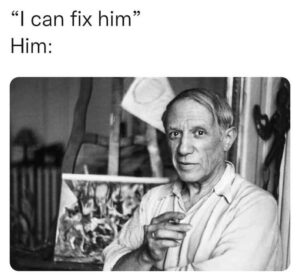
If you could travel in time, when would you go?
I’d be interested to see how much people actually knew about Picasso. I probably wouldn’t want to be in the same room with him! But I am curious to see how much people knew about celebrity artists at the time of their bad practices. I’d go back in time and see what people really knew.
How would you like to be remembered?
The context of people’s work is always changing. I just hope that people remember that I had good intentions and that our standards should always be higher.
All images are property of the artist. You can read about Cem A.’s career here and follow @freeze_magazine here.
